What is solar control?
Our Solar Control Collection contains a number of different sunblind fabrics. The collection has been developed by our engineers and designers and has its own special composition, providing unique function and design. Production takes place using specially constructed machines at our own factory in Kinna, Sweden.
The solar control fabrics are made up almost exclusively of 100% polyester, with the addition of an extremely thin layer of aluminum. The amount of aluminum used for 200m² of fabric is about the same as the amount that would be used in a 33cl drink can.
The aluminum is protected by a thin plastic film in order to optimize the service life of the product. The plastic film does not affect the reflection of the sun to any appreciable extent, but it does protect the aluminum from damage. The thickness of the aluminum layer is optimized to use as little aluminum as possible, without affecting its properties.
Almost all the materials used in the products are flame retardant – the after treatment further reinforces the flame retardancy and at the same time makes the material rigid and durable.

Svensson Solar Control Collection
As all buildings and users have different needs, the Solar control collection is made up of 3 main categories: Energy saving, visual, and mute on.
Energy saving
The collection consists of six different items with an openness factor between 0 and 22%. Each item is available in three to five neutral colour shades. As the side facing the window is made of highly reflective aluminum, the colour facing in towards the room does not affect the properties of the sunblind. The Vivid item comes in 17 different colours and the aluminum side is also slightly tinted.
Visual
The collection consists of 10 items with opens factors 3-30% providing the user with a wide span of colours and pattern to choose from to create the right visual work environment. The items are 100% polyester and the energy effectiveness varies on the colour chosen.
Mute-on
The Mute-on collection consists of items engineered to create the ultimate sound environment. These products can be used as a solar control if they are placed in front of a window, but they may also be used as panels along walls, or as room dividers creating the right sound environment for the room.
Solar control properties
The optical and thermal properties have been measured and interpreted in accordance with EN 14500 and 14501 at the independent Ångström testing institute in Uppsala, Sweden. All our products can be found in the calculation program Parasol, where these sunblinds can be combined with endless combinations of glass. As well as allowing energy simulations to be carried out, this program also indicates what solar factor (g) and heat transfer value (U) will result from the selected glass combination together with the sun blinds.
Why do we use aluminum?
- Is not light-permeable
- Outstanding reflective properties
- Low heat absorbency
- Can be applied in thin layers
- Reflects not only solar radiation but heat radiation as well
Aluminum is the most common metal in the Earth's crust. It is also the third most common element on Earth; the Earth is made up of around 8% aluminum.
Why do we not recycle the aluminum in our Solar control collection?
As we use so little aluminum, attempting to recycle it would not be feasible in terms of energy. The product which contains the most aluminum is Terra. To manufacture 200m2 of this item, we use approximately the same amount of aluminum as would be used in an empty 33cl drink can. If our Solar Control Collection were to be discarded and incinerated after use, no gaseous combustion products would form; it would only give off ash in the form of aluminum oxide, which is a natural component of our world.
Why do we use matt aluminum?
When the surface is smooth, light is reflected at the same angle that it approaches, and so there is a risk of mirroring. When the surface is uneven, the light is reflected in different directions; that is to say, the light is diffused in various directions and so there is no mirroring.